
<< Back | Home | Site Map
Origin of name: Aboriginal - waterhole
Station opened: 26-10-1903
Station closed: By 14-12-1903.
Station re-opened: 12-9-1906
Station closed: 19-3-1989
Distance from Melbourne (via Castlemaine): 322 miles 07 chains 58 links; 518.361 km
Height above Sea Level: 136 feet
During construction of the line, Nowingi was known as Eaglehawk Tank. Nowingi was the end of the line from 25-5- 1903 until the section to Yatpool was opened 30-9-1903.
Nowingi was opened for traffic on 26-10-1903 with no one in charge. Portable buildings were provided and a temporary ash pit was placed on the main line. The station was closed by 14-12-1903.
On 13-8-1906 instructions were issued to put in a short siding at an estimated cost of 20 pounds in connection with the calling of tenders for the erection of an employees residence. The siding, (60 foot clear of scotch blocks), was completed by 15-9-1906 with a staff lock being fitted to the points on 5-9-1906 and it was brought into use on 12-9-1906. The points were secured by a combined Staff Lock and Plunger, the key being the Woomelang - Mildura Train Staff.
Nowingi was reopened by 17-9-1906 with the spelling "Nowingee". A standard mallee shelter shed and locker on a low level platform was provided.
Instructions were issued on 20-11-1907 for the erection of "Limit Boards".
By 21-3-1910 the station was open for goods traffic, with no one in charge, and the name spelt "Nowingi". Instructions were issued on 8-6-1911 to extend the dead-end siding to hold six trucks and to complete the siding to the main line at the down end to form a loop.
Nowingi was supervised by Woomelang until 23-12-1912 when supervision was transferred to Hattah.
The low level platform was extended in 1913. Location boards were removed on 1-11-1922. By 2-12-1924 Nowingi was being worked under caretaker conditions.
Work on the construction of the branch line to open up the Millewa South country commenced on 12-6-1928 with the installation of the junction points at the down end of the station facing down trains. The original surveyed station ground was extended at the down end to accommodate the additional tracks required for the new line. Construction proceeded in a due westerly direction from Nowingi.
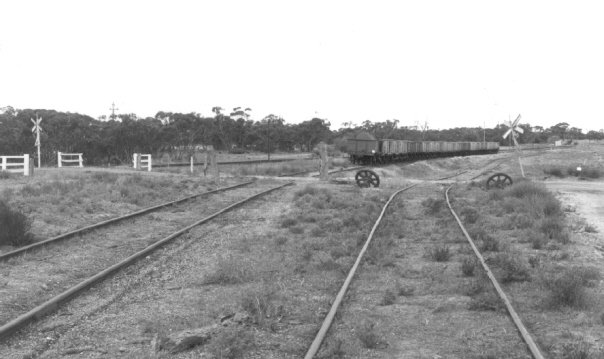
The down end of the Nowingi station reserve showing the main line on the far left, the Victorian Railways maintained section of the branch line in the centre with loaded gypsum wagons and water tank waiting to be picked up, and the Brunswick Plaster Mills siding to the right. The broken axle is off the second IB locomotive. 18-8-1979. Photo: Bruce McLean
On 17-10-1928, at the direction of the Chairman of Commissioners, the District Superintendent, District Rolling Stock Superintendent and District Engineer, all based at Maryborough, along with Construction Engineer and Outdoor Superintendent, inspected the junction at Nowingi and the route of the new line being constructed. In a memorandum dated 8-11-1928, it was considered that the following works should be carried out:
- Provision of a 200 foot long high level passenger platform, office and shelter shed
- Lamp Room (ex Bullarto)
- Ladies and gents toilets
- Van goods shed
- Up and down home signals on the main line and a home signal on the junction line
- Relocation of the telephone from the caretaker's residence to the station office
- Intermediate electric staff instruments for the main line dividing the Hattah - Carwarp section with an installation similar to Hearne's Oak
- A departmental residence for the Maintenance Ganger
- Four room barracks for Repairers
- Tool and Motor Sheds
It was also proposed that the present yard would need to be re-modelled on completion of the new branch line as the construction layout would not be suitable for economical handling of traffic at the junction. It was also planned to have one Ganger and four Repairers with one married Repairer stationed at the terminus of the branch line and his wife to act as Voluntary Caretaker. No staff would be appointed at intermediate stations.
Actual works provided included the passenger platform, shelter shed and relocation of the telephone. Signals and alterations to the yard layout were not considered once the decision to cease construction was made.
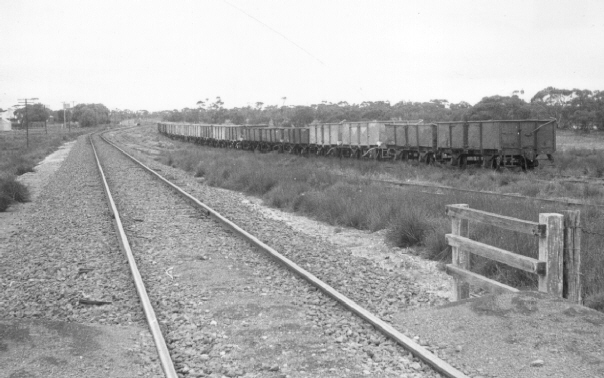
Empty four-wheel open trucks stand on the Brunswick Plaster Mills siding at Nowingi. The line in the centre is the Millewa South branch line. Nowingi station is in the background around the curve. This view was taken in September 1974. Photo: Bruce McLean
Relaying of the main line with 80 pound rails had reached Nowingi by the end of September 1928. Work resumed following a delay obtaining serviceable rails from the Albury line in June 1929.
The Victorian Railways Commissioners, including Chairman Mr. H. Clapp, made an inspection of the Nowingi towards Millewa South line on 24-8-1929 being the only known passenger train to run on the branch line. Details of the special arrangements made for the running of this train can be found in the section on Safeworking.
Nowingi was worked under caretaker conditions under the supervision of Ouyen from August 1931.
Truckloads of gypsum from the extensive deposits adjacent to the Millewa South line were being sent from Nowingi by October 1931. Supplies of fresh water were being sent out for employees of the gypsum companies in rail tanks from Mildura. A special "Dry District Rate" was applied for water freight between Mildura and Nowingi.
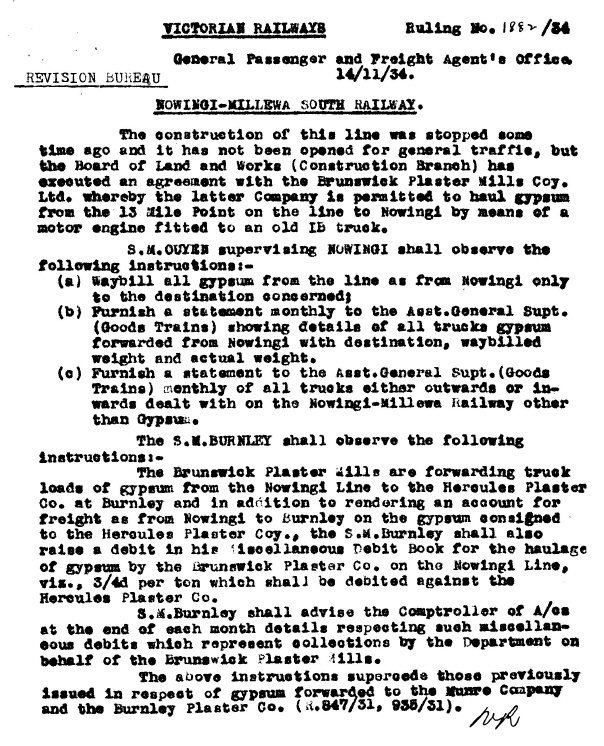
Instructions issued in 1934 to the Stationmasters at Ouyen and Burnley for the financial control of gypsum traffic from Nowingi. Source: Bruce McLean Collection
The Brunswick Plaster Mills advised in September 1936 that they were hoping to deliver over 600 tons of gypsum weekly from the Millewa South - Nowingi line.
The only source of water supply at Nowingi came from an iron-clad catchment tank, erected in 1927. In November 1947, the Department of Lands called tenders for the removal of two catchments, one in the Parish of Nowingi and the other in the Parish of Nurnuremal, both on abandoned blocks. Apparently the successful tenderer mistook the locality at Nowingi and dismantled the tank at Nowingi station. In 1994, members of the Rotary Club of Red Cliffs began restoration of the tank and it was officially "re-opened" by Mr. R. Savage M.L.A. on 19-5-1996.
Two departmental residences were provided. The dates of establishment have not been determined, however we know that No.1780 was occupied from 22-7-1921 until it was put up for sale and removal on 27-6-1973. No.1717 was occupied from 7- 9-1920. It was sold for removal on 29-11-1976.
Departmental records show that this house was occupied by Repairer A. Smith from 17-4-1924 to 19-7-1925. Repairer A. Smith's adopted daughter, Patsy Adam-Smith, the well known author of many railway theme books, spent 15 months of her infancy here and has used the brief experience to chronicle railway life in this remote railway locality and writing about construction of the Millewa South railway even though construction did not commence until 1928 when she was about 4 years of age and had moved away from the area.
A hut was attached to this residence for postal purposes, the caretaker (usually the ganger's wife) also acting as Postmistress. The Postmaster General's department paid an annual rent for the facility.
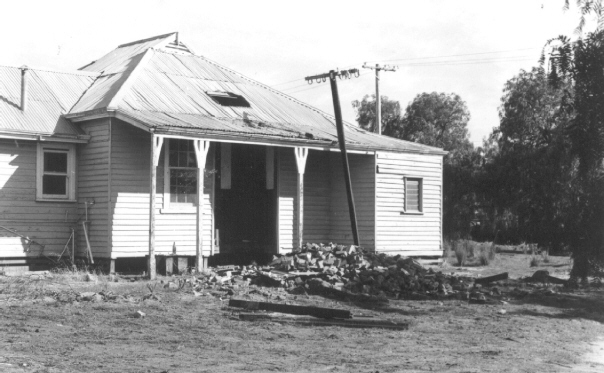
Departmental residence 1717 at Nowingi. This house is where Repairer Albert Smith and his family lived when daughter, author Patsy Adam-Smith, was an infant. Demolition of the brick chimney has taken place prior to removal. 1977. Photo: Bruce McLean
Bungalow No.2908 was first occupied on 13-8-1928 and was removed to Hattah on 26-2-1938.
Nowingi could be opened as an intermediate composite electric staff block post in the electric staff section Hattah - Carwarp, providing Boonoonar was not open.
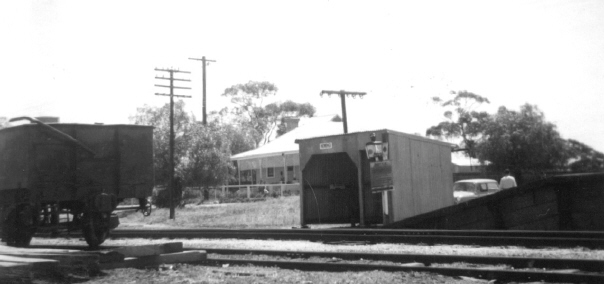
Nowingi Station 1967. Note the well maintained departmental residence in the background, the lamp with instructions for passengers wishing to board the train at night, and the mallee-type waiting shed. Photo: Bruce McLean
Gypsum freight tonnage from Nowingi continued to be the principal purpose for the existence of the station as passenger traffic was negligible, the year ending June 1968 for example showing only 3 outwards passengers.
Nowingi was worked under No One in Charge conditions from 1-5-1973.
In March 1975 the Victorian Railways announced that they were considering closing small stations that were being served by "The Vinelander" passenger train between Melbourne and Mildura. Nowingi had handled only eight passengers in the past four years and parcels traffic had been negligible. As a consequence, Nowingi was closed to passengers from 10-11-1975.
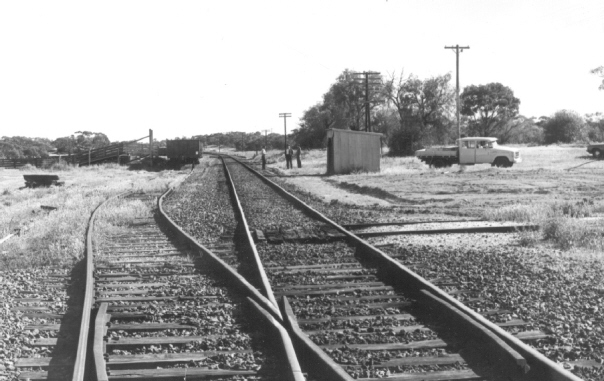
The Nowingi short high level platform was removed in September 1977. Evidence of the platform's location can be seen parallel to the main line near the mallee shelter shed. 1-10-1977. The concrete blocks used for the station platform facing were salvaged for use in the extension of the up end of the Mildura station platform. Photo: Bruce McLean
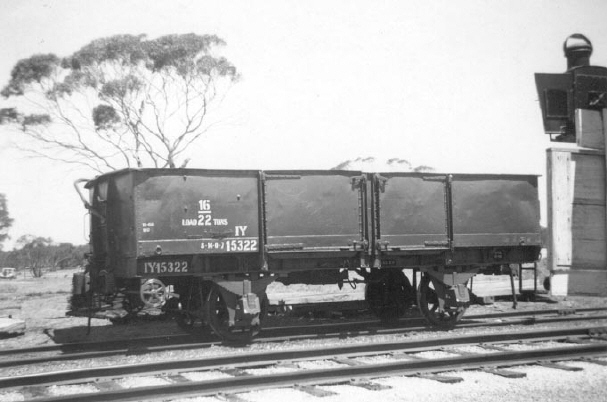
IY15322 was freshly painted after a workshop overhaul. It was sent to Nowingi with a load of steel sleepers and was photographed in the siding opposite the Nowingi station lamp in 1967. Photo: Bruce McLean
In the financial year ending 30-6-1970, 24,000 tons of gypsum was railed from Nowingi.
The platform was removed in September 1977. The concrete slabs from the platform retaining wall were recovered for use at Mildura where the Up end of the platform was extended.
The sheep race was removed by 13-12-1983.
With the cessation of gypsum mining, the former Millewa South branch line leased by the Colonial Sugar Refining Company was no longer required and the points in the main line were spiked normal on 16-11-1987.
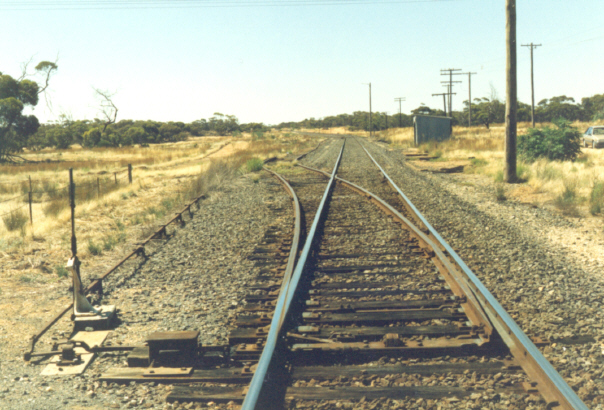
The points leading to the Millewa South line were spiked for the main line on 16-11-1987. Photo: Bruce McLean.
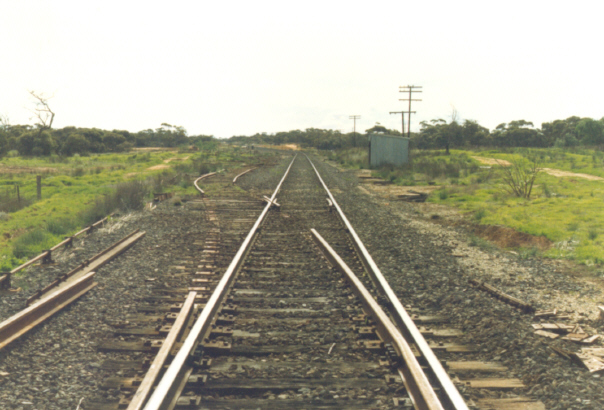
Dismantling of the Nowingi to Millewa South line and siding was undertaken by V/Line in July 1988. Dismantling of the Millewa South line was undertaken separately by a private contractor. 13-7-1988. Photo: Bruce McLean
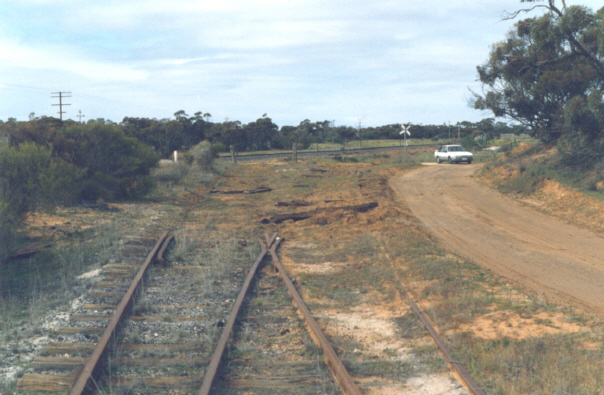
The Millewa South line (on left) and siding were dismantled by V/Line up to this point. 5-8-1988. Photo: Bruce McLean
The up end points siding points and the points to the Millewa South line were removed on 14-9-1988.
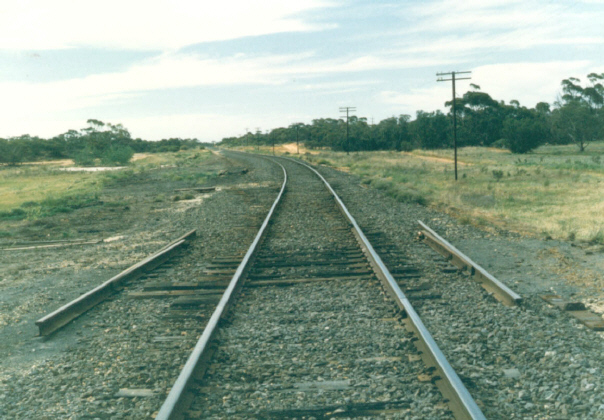
The points leading to the Millewa South line were removed on 14-9-1988 and the main line "straight-railed". 2-10-1988. Photo: Bruce McLean
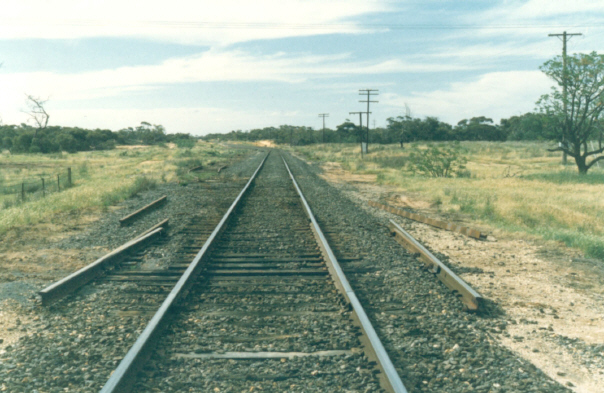
The up end points leading to the Nowingi siding and connecting to the Brunswick Plaster Mills siding, were removed from the main line on 14-9-1988. The down end points for the Millewa South line were also removed the same day (just before the curve in the distance). 2-10-1988. Photo: Bruce McLean
With the introduction of Train Order working between Dunolly and Mildura, Nowingi was disestablished as an intermediate composite electric staff block post on 19-3-1989, effectively closing Nowingi for any useful purpose.
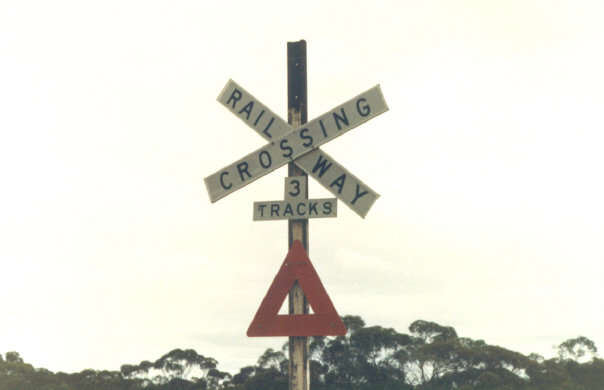
The railway crossing at the down end of Nowingi indicated the status of three tracks were required to be crossed by motorists during the operational years of the Millewa South line. The "3 Tracks" sign has been preserved at the Meringur Pioneer Museum. 16-4-1989. Photo: Bruce McLean
| << Back | Home | Site Map | Copyright © 2003 Bruce McLean, All Rights Reserved |